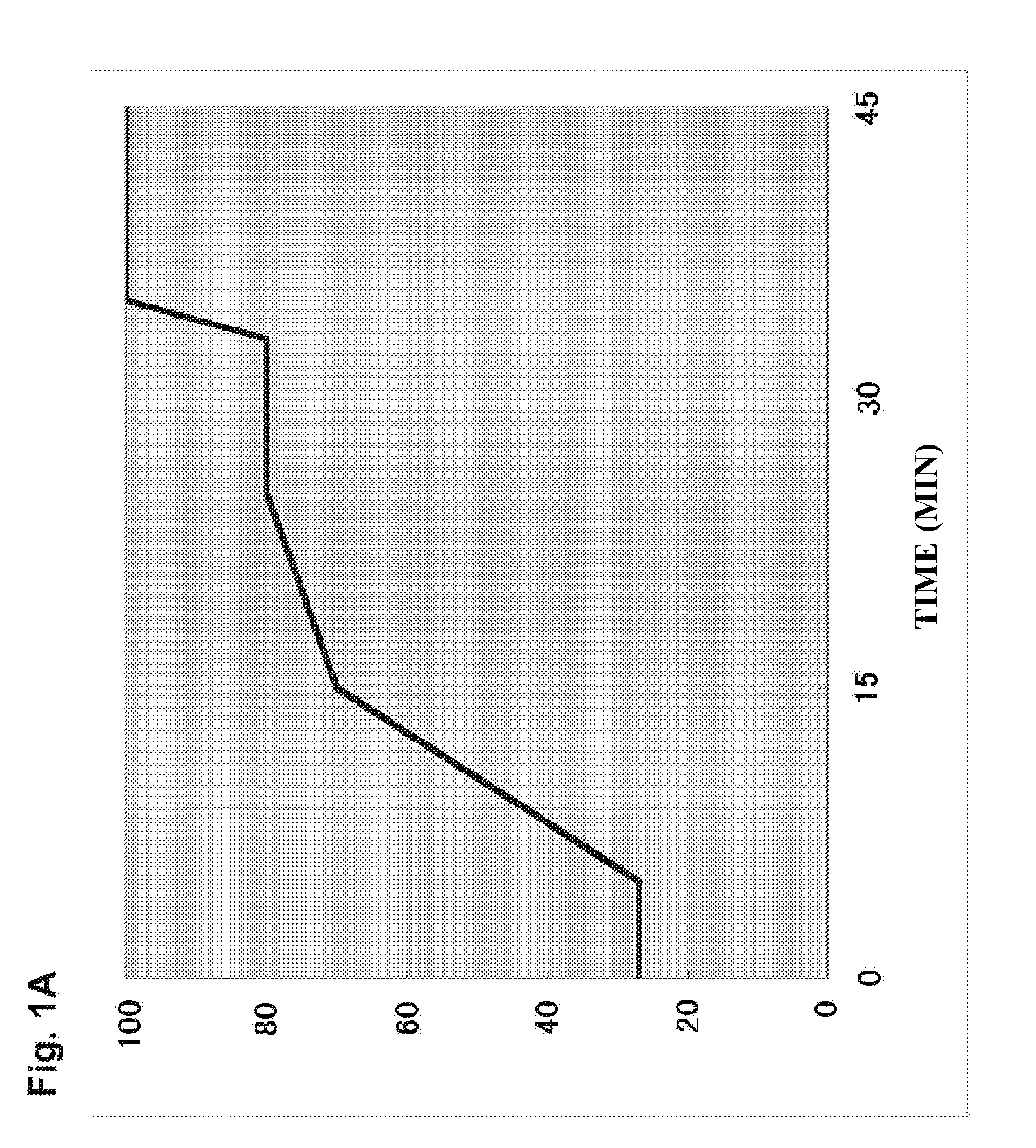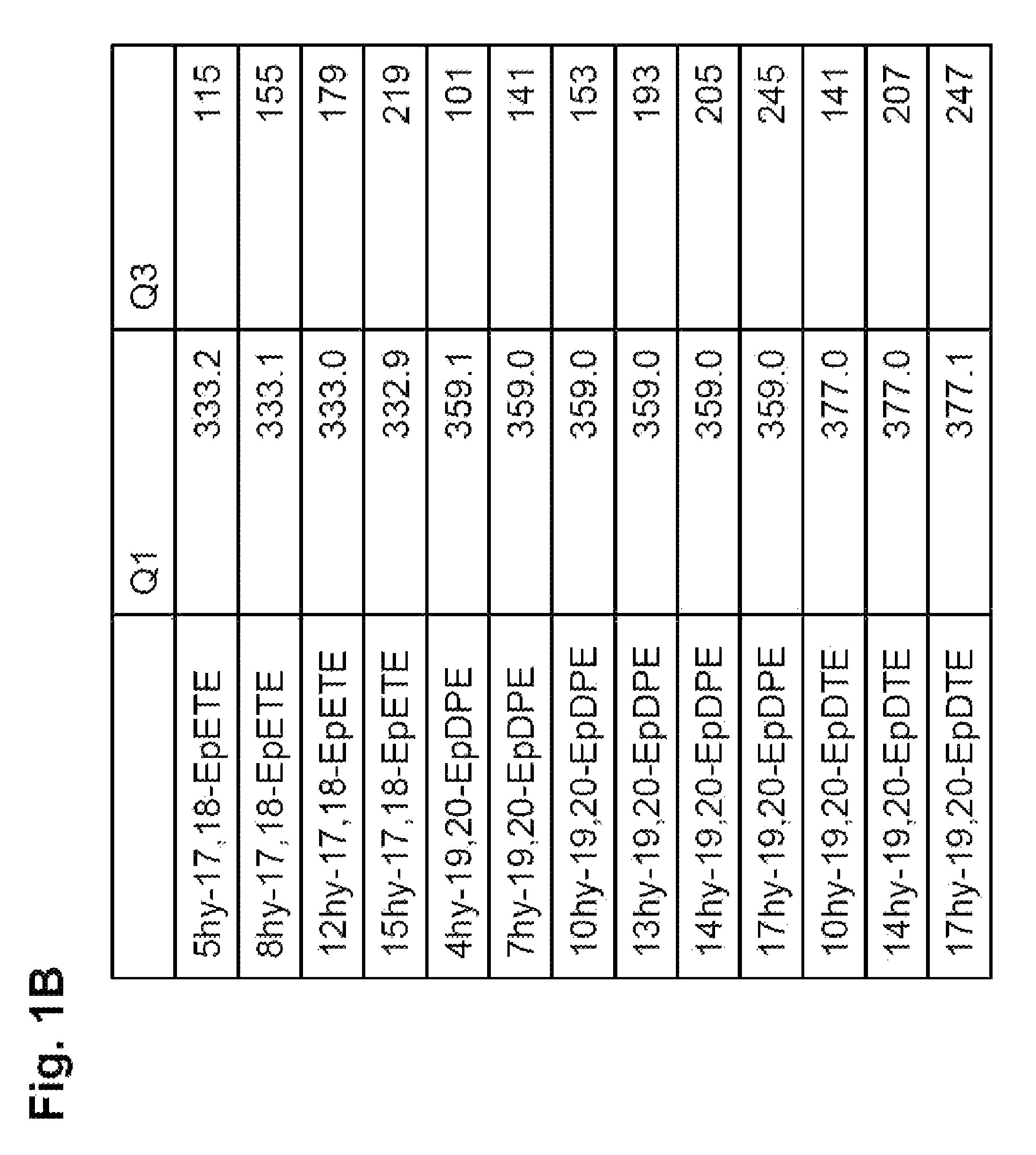Anti-inflammatory metabolite derived from omega-3-type fatty acid
a metabolite and omega-3-type fatty acid technology, applied in the field of new anti-inflammatory compounds, can solve the problems of increasing the risk of cardiac disease, and no evidence whatsoever that such compounds actually possess anti-inflammatory activity, and achieve the effect of suppressing tissue infiltration and few adverse effects in administration
- Summary
- Abstract
- Description
- Claims
- Application Information
AI Technical Summary
Benefits of technology
Problems solved by technology
Method used
Image
Examples
example 1
Establishment of a High-Sensitivity Analytical Method for PUFA Metabolites of Epoxy Compounds of the Present Invention
[0508]In this example, a system capable of quantitatively analyzing PUFA metabolites at high sensitivity and quantitatively analyzing many types at once was established to make possible the analysis of novel compounds. In this example, a simultaneous quantitative analysis system for polyunsaturated fatty acids (PUFA) by multiple reaction monitoring (MRM) using ultra-high-performance liquid chromatography-tandem mass spectrometry (UPLC-MS / MS) was established.
[0509]MRM is a technique that permits the selective analysis of target metabolites at high sensitivity using MS / MS. When the MS / MS of metabolites of PUFA is measured, if they are oxides for example, fragmentation occurs at the carbon-carbon bonds in front of and behind their hydroxy groups. When this occurs, a characteristic MS / MS value is detected in the structure of that metabolite. Therefore, MRM is a technique...
example 2
Synthesis of 5-hydroxy-17,18-epoxy-ETE, 4-hydroxy-19,20-epoxy-DPE, 7-hydroxy-19,20-epoxy-DPE, 13-hydroxy-19,20-epoxy-DPE, 10-hydroxy-19,20-epoxy-DTE, 14-hydroxy-19,20-epoxy-DTE, and 17-hydroxy-19,20-epoxy-DTE
[0558]The title compounds were synthesized in this example. In this example, a method was used whereby a hydroxy compound was produced first, and the hydroxy compound obtained was epoxidated.
[0559](Materials)
[0560]3-Morpholinopropanesulfonate buffer (MOPS buffer) (pH 7.4): MOPS (Wako Pure Chemical Industries) was dissolved in Milli-Q water. The pH was set at 7.4 by adding 1N sodium hydroxide (Wako Pure Chemical Industries), and MOPS was then brought to 50 mM by Milli-Q water.
[0561]Recombinant cytochrome P450 BM3: The target gene was induced by adding pentobarbital to make 1 μM to Bacillus megaterium. The RNA was extracted from it, amplified by RT-PCR, inserted into a pET21a DNA (Takara) vector, and transformed in BL-21 competent cells. E. coli with the gene introduced was cultur...
example 3
Synthesis of 12-hydroxy-17,18-epoxy-ETE and 14-hydroxy-19,20-epoxy-DPE
[0592]In this example, of 12-hydroxy-17,18-epoxy-ETE and 14-hydroxy-19,20-epoxy-DPE were synthesized.
[0593](Materials)
[0594]Materials used to produce hydroxy compounds by enzymatic reaction:
[0595]Tris hydrochloride buffer (also referred to as “Tris” in the present specification) (pH 7.4): Tris was dissolved in Milli-Q water. The pH was set at 7.4 by adding concentrated hydrochloric acid, and Tris was brought to 100 mM by Milli-Q water.
[0596]Recombinant Porcine 12-LOX: Sigma
[0597]Sodium tetrahydroborate (sodium borohydride, NaBH4): Wako Pure Chemical Industries
[0598]17,18-Epoxy ETE and 19,20-epoxy DPE: Cayman
[0599]Diethyl ether: Showa Ether
[0600]Material used in separation by reverse-phase HPLC:
[0601]Methanol: Wako Pure Chemical Industries
[0602]0.01% v / v acetic acid: Acetic acid (Wako Pure Chemical Industries) was added to Milli-Q water to make 0.01% by v / v.
[0603](Method)
[0604](Synthesis by Enzymatic Reaction)
[0605...
PUM
| Property | Measurement | Unit |
|---|---|---|
| flow rate | aaaaa | aaaaa |
| flow rate | aaaaa | aaaaa |
| flow rate | aaaaa | aaaaa |
Abstract
Description
Claims
Application Information
 Login to View More
Login to View More - R&D
- Intellectual Property
- Life Sciences
- Materials
- Tech Scout
- Unparalleled Data Quality
- Higher Quality Content
- 60% Fewer Hallucinations
Browse by: Latest US Patents, China's latest patents, Technical Efficacy Thesaurus, Application Domain, Technology Topic, Popular Technical Reports.
© 2025 PatSnap. All rights reserved.Legal|Privacy policy|Modern Slavery Act Transparency Statement|Sitemap|About US| Contact US: help@patsnap.com



